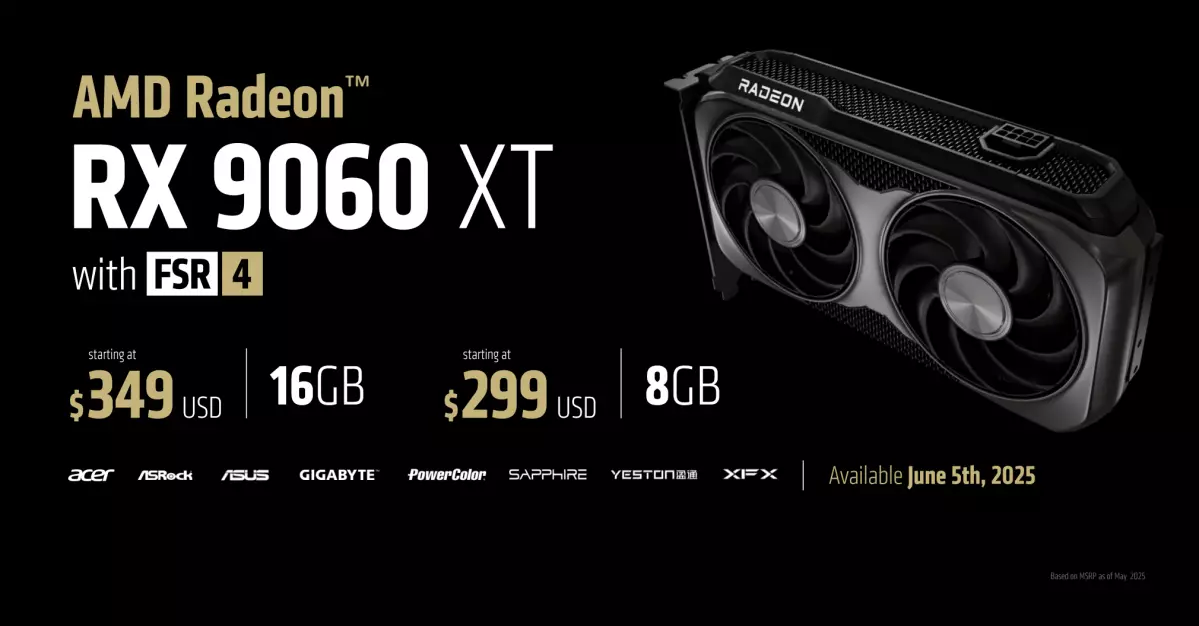In the ever-evolving battleground of graphics processing units (GPUs), AMD has made a significant mark by announcing its latest offering—the Radeon RX 9060 XT. This new GPU, unveiled at Computex, is not just another addition to AMD’s lineup; it represents a strategic maneuver designed to directly contend with Nvidia’s recently launched RTX 5060 and RTX 5060 Ti. However, the absence of clear pricing and release dates for the RX 9060 XT leaves many enthusiasts speculating about AMD’s marketing strategy and their faith in this new technology.
AMD has unveiled two models of this graphics card, catering to varying user needs with 8GB and 16GB of VRAM. The prices of $299 for the 8GB model and $349 for the 16GB variant effectively position AMD to challenge Nvidia while also igniting discussions over the industry-standard GPU memory specifications. The looming issue surrounding VRAM in modern gaming environments cannot be brushed aside. While AMD clearly trails Nvidia in the rollout, the timing is curious, particularly as demands for more memory continue to rise alongside the complexity of new game releases.
Navigating the VRAM Debate
The VRAM conundrum underscores a broader concern shared among gaming communities. As games evolve, the need for more robust memory to handle high-resolution textures and intricate rendering becomes non-negotiable. The gaming landscape in 2025 is already controversial, with both hardware giants facing dissatisfaction over their respective decisions to equip flagship GPUs with only 8GB VRAM. AMD’s move, while seemingly mimicking Nvidia’s approach, could either be a strategic blunder or a calculated risk designed to attract a loyal customer base seeking performance balanced by cost.
This discussion is not merely academic; it bubbles with palpable tension among PC gamers and content creators alike. Reactions to AMD’s VRAM strategy will be critical in shaping consumer trust. AMD has undoubtedly placed itself at the center of this fray, raising the stakes significantly as the RX 9060 XT arrives in a marketplace where consumer expectations have surged.
Performance Predictions and Comparisons
Performance comparisons between the RX 9060 XT and its Nvidia counterparts are inevitable. AMD boldly claims that their 16GB version will outperform the RTX 5060 Ti by approximately 6% at 1440p resolution based on internal testing across 40 games. Yet, one must approach such proclamations with a degree of skepticism. The benchmarks are likely to spur extensive testing by independent reviewers, who will play a crucial role in validating AMD’s claims. AMD has a history of impressive specs on paper that have occasionally stumbled in the real world.
The mention of an impressive boost clock speed of 3.13GHz further amplifies the excitement surrounding the new GPU. Nevertheless, the actual power draw, ranging from 150 to 182 watts, raises questions about energy efficiency, especially in a market increasingly aware of sustainability. The performance of AMD’s RDNA 4 architecture under load and its thermal management will be critical to its long-term success.
Reactions in the Gaming Community
In the wake of AMD’s announcement, reactions from the gaming community and content creators have been as charged as expected. Nvidia’s methods, notably its withholding of review samples and driver access for the RTX 5060, have caused ripples of discontent. Gamers Nexus has highlighted the contentious tactics employed by Nvidia, which has driven some community members to openly express their frustration. Instead of arousing excitement for their launch, Nvidia finds itself in a defensive position, forced to justify its RAM choices amid growing scrutiny.
This dynamic paints an intriguing picture for AMD as they prepare for the RX 9060 XT’s entry into an increasingly competitive landscape. While AMD must tread carefully, it also has the unique opportunity to capitalize on Nvidia’s missteps—capturing the hearts and wallets of gamers yearning for transparency and power. The excitement tension may ultimately secure AMD a dedicated following, driving home the point that in tech, consumer sentiment is just as critical as specs and performance.
With the RX 9060 XT, AMD stands at a crossroads. The market’s reaction, consumer trust, and performance will shape the future narrative of both companies. The stage is set for a thrilling GPU clash that could redefine gaming standards for years to come.

